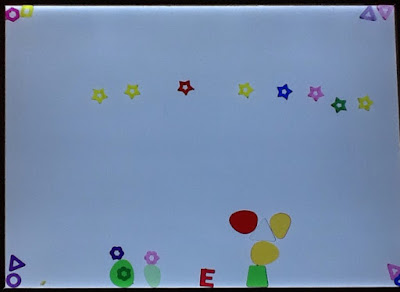When I think back to elementary school, I remember many "one size fits all" art projects. Sure, they were cute, but they all looked the same. One project stands out, however. It was fifth grade, and we got to carve bars of Ivory soap in art class. I remember being extremely proud of my carving, because it didn't look like anyone else's. Chances are, it wasn't gallery worthy, but it was memorable, nonetheless.
There is truth to the saying we teach what we know, because for many years as a teacher, I had my students create lovely art projects that were all relatively cookie cutter. It wasn't until about 8 or 9 years ago that I started to appreciate the value in maintaining individuality while at the same time, encouraging creativity. Looking back, I think it had a lot to do with letting go of the control over the project, and the need to have things look a certain way. As I did that, I came to appreciate the beauty in children's artwork and I also began to realize how much I could learn about a child simply by viewing their creative expressions. In fact, now when I see a cookie cutter art project, I reflexively cringe on the inside.
With the push down of academic standards, creativity has been shoved by the wayside. This year, as part of my goal to make the classroom the third teacher, I have been experimenting with ways to keep creativity alive in the classroom, while at the same time maintaining individuality. It is constant journey, but here is what I have come up with so far:
Directed Projects
The thing I like about directed projects is they allow a child to create something beautiful, but they do not all look the same. Five and six year old children have limited artistic skills, so we still need to model some things for them. Directed projects allow this to happen. In the past month, I have done two directed projects with my class. The first was a Statue of Liberty directed drawing we did as part of our study of U.S Symbols. This project idea came from a unit I purchased from Deanna Jump on TPT. This is the third year I have done this project, and I am amazed every year how beautiful they turn out.
Just this past week, I did a directed multimedium project with my class as part of our star inquiry. I got the idea from the smartteacher.com. Again, I love how this project encouraged the children to be creative, but maintained their individual styles.
Discovery Time Provocations
Using the classroom as the third teacher has become vital to the success of my classroom. When I set up provocations, I try to think of ways students can be creative with materials without teacher direction. This allows all children to achieve success because there are not parameters they must follow or meet. Children are free to create as they choose.
 |
| This student documented what she observed at the science table. She explained that the stem was curvy and the brown spots on the side were where the pumpkin had been chewed on by an animal. |
 |
| Makerspaces such as this one allow children to design and create anything they choose using the materials available to them. |
 |
| Allowing free access to materials such as paper, markers, stapler, glue, etc. lets students know that you value creativity and trust them to create freely. |
 |
| Originally, I had a color scheme in mind for our star cave, but I love the way the students took the initiative to paint it the way they saw fit. |
 |
| The art easels are always open, encouraging students to paint whenever they feel the desire. |
 |
| Changing the materials at the light table encourages students to create in new ways. |
 |
| Mosaic tiles allow students to create using the colors and design they choose. This student created a skateboard. |
 |
| A cheap Dollar Tree frame and some objects from nature inspired this creative collage. |
Projects Which Allow for Variation
Maintaining individuality doesn't have to mean different projects for everyone. Simply allowing the children to cut, tear and create the project that you describe rather than using pre-cut pieces encourages a child to be creative and successful in his/her own way, as these projects demonstrate.
 |
| Torn paper flags created as part of our study of U.S. symbols |
 |
| Another torn paper project--carrots created during our carrot inquiry. |







I was sad when you took down your Statue of Liberty projects. They encouraged some conversation amongst my students when we passed them each day! You are doing some great things with your students!
ReplyDeleteThank you, Suzy! Yes, I love those projects. I am always amazed at how much they look like the real thing, and yet they all look so different!
DeleteI love the tearing of construction paper to make the US Flag. So fitting for this November. The embedded sensory tactile activities are instrumental for so many children who do not have this exposure.
ReplyDeleteThank you, Eric!
Delete